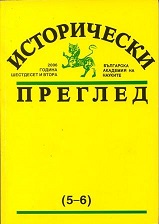Приносът на сфрагистиката за разкриване девалвацията на византийските почетни титли в йерархията на т. нар. система на предимство от ...
The Contribution of Sigillography in Elucidating the Devaluation of byzantine Honorific Titles in the Hierarchy of the So-Called System of ...
Author(s): Nikolay KanevSubject(s): History
Published by: Институт за исторически изследвания - Българска академия на науките
Summary/Abstract: The Contribution of Sigillography in Elucidating the Devaluation of byzantine Honorific Titles in the Hierarchy of the So-Called System of Precedence in the Mid-Byzantine Period – the Example of the Titles Magistros and Patrikios (late 8th/early 9th century to late 11th/early 12th century) / Rank hierarchy played a significant role in the life of Byzantium, especially in the Byzantine state system, as it expressed the idea of taxis and the harmonious order of the earthly world modeled on the heavenly one. The model of the Byzantine rank hierarchy in the 9th–11th centuries finds expression in the specific system of precedence with the hierarchy of honorific titles constituting the basic element of its structure. The devaluation of the Byzantine titles is in a sense symptomatic of the state of the Empire and the deepening of the process is a perfect illustration of the crisis Byzantium fell into in the 11th c. The data from Byzantine lead seals are of foremost importance for the elucidation of the process. On the basis of the currently available sigillographic data, the paper examines the devaluation of the two titles magistros and patrikios, which were some of the basic high honorific ranks for the Byzantine elite outside the imperial family and relations. Patrikios is the oldest high title granted to the representatives of the elite, and until the mid-11th c. magistros was the uppermost rung in the hierarchy reserved for dignitaries belonging to the so-called „bearded“ category, i.e. non-eunuchs. The sigillographic information available from various corpuses, studies and articles published between the second half of the 19th c. and the first decade of the 21st c. has been thoroughly studied. Accordingly, two hundred and ten magistroi and seven hundred and fifty-eight patrikioi are attested by their more or less precisely dated seals for a period of nearly 350 years; from the late 8th c. until the early 12th c. The lead seals of only 13 magistroi (only 6.19% of the total number of the title-bearers of magistros) and as many as 205 patrikioi (27.04%) are dated to the beginning of the period under consideration through the end of the 9th century. Twenty-one magistroi and a hundred and four patrikioi (10.48% and 13.72% respectively) should be definitely attributed to the 10th c., while a hundred and fifty-seven magistroi and three hundred and thirtyfive patrikioi (74.76% and 44.20% respectively) to the 11th – early 12th centuries. The seals of 4 magistroi (1.90%) and 38 patrikioi (5.01%) are more general and borderline cases, dated to the 9th-10th centuries, while 14 magistroi and 76 patrikioi (6.67% and 10.03% respectively) to the 10th–11th centuries. A clearly distinguished process of devaluation has been ascertained, which increased in the 11th c., especially in its second half (at least 181 patrikioi and 115 magistroi are attested through their seals from the mid-11th c. onward!). Along with that, the rate of the title devaluation before the ..
Journal: Исторически преглед
- Issue Year: 2011
- Issue No: 5-6
- Page Range: 265-272
- Page Count: 8
- Language: Bulgarian
- Content File-PDF

